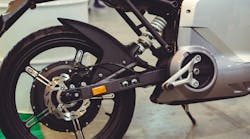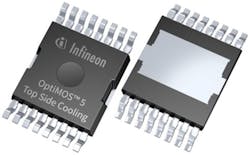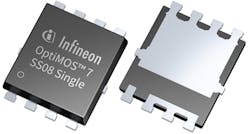New EV-Focused MOSFETs Come in Compact Packages
Electrification of transportation isn’t relegated to just passenger cars and commercial trucks—two- and three-wheelers and 3-wheelers are firmly in the midst of this transformation. As a result, the automotive market for electronic control units (ECUs) requiring 24 to 72 V is expected to continue ramping up.
To address this development, Infineon Technologies is expanding its OptiMOS 5 portfolio of automotive MOSFETs in the 60- and 120-V range with products in TO-leadless (TOLL), TO-leaded with gullwing (TOLG), and TO-leaded top-side cooling (TOLT) packages. These offer a compact form factor with good thermal performance combined with first-class switching behavior.
Applications for Infineon's Automotive MOSFETs
The company’s automotive MOSFETs are used to drive motors in a wide range of applications, such as pumps, fans, ventilation, seat adjustment, or sunroofs. They also find homes in safety-critical applications like electric power steering (EPS), electric braking, and injection systems. What’s more, they act as switches in onboard chargers, HV/LV DC-DC converters, battery-management systems, and inverters.
Infineon’s MOSFET portfolio includes P-channel, N-channel, and dual-channel varieties for automotive applications qualified to AEC-Q101 and beyond.
OptiMOS 5 Features
Six new OptiMOS 5 products offer a narrowed gate threshold voltage (VGS(th)), enabling designs with parallel MOSFETs for increased output power capability. The IAUTN06S5N008, IAUTN06S5N008G, and IAUTN06S5N008T are 60-V MOSFETs, and the IAUTN12S5N017, IAUTN12S5N018G and IAUTN12S5N018T are 120-V MOSFETs.
On-resistance (RDS(on)) ranges from 1.7 to 1.8 mΩ for the 120-V MOSFETs and it’s 0.8 mΩ for the 60-V versions. This makes them well-suited for high power 24-V supplied clean-air-vehicle (CAV) applications or for HV-LV DC-DC converters in EVs. The 120-V devices can be used in 48- to 72-V supplied traction inverters for two- or three-wheelers and light electric vehicles.
One attractive feature of this family is the reduced gate threshold voltage (VGS(th)), which enables designs with parallel MOSFETs, boosting output power capabilities. Samples of the new OptiMOS 5 products can be ordered now.
Arrival of the Next-Gen OptiMOS 7
Infineon also is introducing its next leading MOSFET generation called OptiMOS7. It will enable higher power efficiency, reduced switching losses, and increased safe operating area (SOA) for high-current applications in combination with packages that have small footprints.
The 300-mm thin-wafer technology OptiMOS7 family targets all standard and future automotive 40-V MOSFET applications, such as electric power steering, braking systems, disconnect switches, and new zone architectures. With its wide range of variants, OptiMOS 7 is also aiming at battery management, e-fuse boxes, as well as DC-DC and BLDC drives.
“The OptiMOS 7 40-V MOSFET family will set a new benchmark in power density, current capability, and chip ruggedness,” said Axel Hahn, Senior Vice President Automotive MOSFET of Infineon. “The devices offer the highest power density and energy efficiency with the industry’s lowest on-state resistance.”
OptiMOS 7 MOSFETs feature reduced switching losses, improved SOA robustness, and high avalanche current capability. The parts come in automotive standard SSO8 5x6 (TDSON-8) power packages. These packages provide a high current capability of 175 A with a small footprint of 30 mm2. Other packages include HSOF-5, HSOF-8, and topside cooling. The family enables high system efficiency in the smallest form factor while reducing space requirements. In addition, they help improve cooling while reducing system costs.
Infineon’ s OptiMOS 7 focuses on high-power automotive applications, especially electric power-steering EPS, safety switches, DC-DC braking systems, power disconnect switches in zonal architectures, battery management, eFuse boxes, and all BLDC drives in CO2-friendly vehicles. On-resistance (RDS(on)) ranges from 0.42 to 3.0 mΩ.


